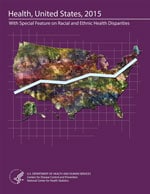Health, United States 2015 
You are subscribed to receive email updates regarding Health, United States from the National Center for Health Statistics, Centers for Disease Control and Prevention. The following information has been updated: “Health, United States 2015” with “Special Feature on Racial and Ethnic Health Disparities” is available on the NCHS web site at the following address: http://www.cdc.gov/nchs/hus.htm. Learn More >> 39TH ANNUAL “REPORT CARD ON THE NATION’S HEALTH” SHOWS RACIAL AND ETHNIC HEALTH DISPARITIES PERSIST The U.S. Department of Health and Human Services has released “Health, United States, 2015”. This is the 39th annual report card on the nation’s health, along with a special feature on racial and ethnic health disparities. The special feature was inspired by the landmark 1985 Report of the Secretary's Task Force on Black and Minority Health, which documented significant health disparities among racial and ethnic groups. Some of the highlights from the Special feature include: - The difference between the highest (non-Hispanic black) and lowest (non-Hispanic Asian or Pacific Islander) infant mortality rates among the five racial and ethnic groups narrowed from 9.41 deaths per 1,000 live births in 1999 to 7.21 in 2013.
- During 1999–2014 non-Hispanic black mothers experienced the highest percentage of low-risk cesarean deliveries (29.9 percent in 2014) among the five racial and ethnic groups while non-Hispanic American Indian or Alaska Native mothers experienced the lowest (21.5 percent in 2014).
- Among Hispanic mothers during 1999-2014, Cuban mothers experienced the highest percentage of low-risk cesarean deliveries among the five Hispanic-origin groups (41.4 percent in 2014) while Mexican mothers experienced the lowest (24.1 percent in 2014).
- In 2011–2014 for children and adolescents aged 2–19 years, Hispanic children and adolescents had the highest prevalence of obesity (21.9 percent) and non-Hispanic Asian children and adolescents had the lowest prevalence (8.6 percent).
- The difference for women between the highest (non-Hispanic white) and lowest (non-Hispanic Asian) percentages of current cigarette smokers among racial and ethnic groups narrowed from 17.5 percentage points in 1999 to 13.2 in 2014 (percentages are age-adjusted).
- The difference between the highest and lowest percentage of uninsured adults aged 18-64, narrowed from a difference of 24.9 percentage points in 1999 (Hispanic adults compared with non-Hispanic white adults) to a difference of 19.9 percentage points in the first six months of 2015 (Hispanic adults compared with non-Hispanic Asian adults).
- In 2014 among adults aged 18-64, Hispanic adults had the highest percentage of those not receiving needed dental care in the past 12 months due to cost (15.7 percent) and non-Hispanic Asian adults had the lowest percentage (6.3 percent).
“We have seen important improvements in some health measures for racial and ethnic minority populations since the Heckler Report elevated minority health onto a national stage in 1985,” said J. Nadine Gracia, MD, MSCE, deputy assistant secretary for minority health and director of the HHS Office of Minority Health. “While there has been significant progress in our journey toward health equity, disparities still exist and we must remain vigilant in our efforts to end health disparities in America.” “Health, United States, 2015” was prepared by CDC’s National Center for Health Statistics (NCHS). The report includes data from a variety of federal government and private sector sources and is organized around four major areas: health status and determinants, health care utilization, health care resources, and health care expenditures. Selected highlights from these sources include: - Between 2013 and 2014, the percentage of adults aged 18–64 who were uninsured declined by 28 percent in states that expanded their Medicaid programs to include low-income adults, and declined by 14 percent in states that did not expand their Medicaid programs.
- In 2014, 23.4 percent of all emergency department visits for adults aged 18-64 were by those with Medicaid; 15.1 percent were by the uninsured, and 53.6 percent were by those with private coverage, reflecting the larger percentage of adults with private coverage.
- In 2014, prescription drug expenditures totaled $297.7 billion—up 12.2 percent from $265.3 billion in 2013.
- In 2013, about 8 of every 10 office-based physicians had computerized electronic health record components that recorded patient history and demographic information, ordered prescriptions, and submitted prescriptions to the pharmacy. About 7 of 10 had components to order lab tests and provide electronic warnings of drug interactions and contraindications.
While the NCHS report focuses on health outcomes, a complementary report, from HHS’s Agency for Healthcare Research and Quality, focuses on health care. Together, these reports provide the most comprehensive assessment of health, health care, and disparities in the U.S. and track progress of the National Quality Strategy toward better care, healthy communities, and smarter spending. “Health, United States 2015” with “Special Feature on Racial and Ethnic Health Disparities” is available on the NCHS web site at the following address: http://www.cdc.gov/nchs/hus.htm. Learn More >>
| This email was sent to filter@clubhouseb.com using GovDelivery,on behalf of: Centers for Disease Control and Prevention • 1600 Clifton Rd • Atlanta, GA 30333 • 1-800-CDC-INFO (800-232-4636) |  | |




No comments:
Post a Comment